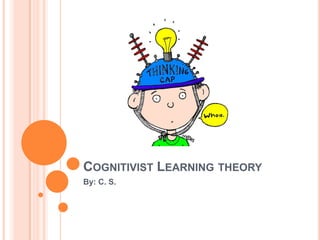Learningtheoriesppt 100415125913-phpapp01
•Download as PPTX, PDF•
2 likes•1,738 views
Report
Share
Report
Share

Recommended
Recommended
God is a creative God Gen 1:1. All that He created was “good”, could also be translated “beautiful”. God created man in His own image Gen 1:27. Maths helps us discover the beauty that God has created in His world and, in turn, create beautiful designs to serve and enrich the lives of others.
Explore beautiful and ugly buildings. Mathematics helps us create beautiful d...

Explore beautiful and ugly buildings. Mathematics helps us create beautiful d...christianmathematics
More Related Content
Similar to Learningtheoriesppt 100415125913-phpapp01
Similar to Learningtheoriesppt 100415125913-phpapp01 (20)
Design for networked learning: framing relations between participants’ activi...

Design for networked learning: framing relations between participants’ activi...
Combining content analytics and activity tracking to mine user interests and ...

Combining content analytics and activity tracking to mine user interests and ...
Recently uploaded
God is a creative God Gen 1:1. All that He created was “good”, could also be translated “beautiful”. God created man in His own image Gen 1:27. Maths helps us discover the beauty that God has created in His world and, in turn, create beautiful designs to serve and enrich the lives of others.
Explore beautiful and ugly buildings. Mathematics helps us create beautiful d...

Explore beautiful and ugly buildings. Mathematics helps us create beautiful d...christianmathematics
This presentation was provided by William Mattingly of the Smithsonian Institution, during the fourth segment of the NISO training series "AI & Prompt Design." Session Four: Structured Data and Assistants, was held on April 25, 2024.Mattingly "AI & Prompt Design: Structured Data, Assistants, & RAG"

Mattingly "AI & Prompt Design: Structured Data, Assistants, & RAG"National Information Standards Organization (NISO)
This presentation was provided by William Mattingly of the Smithsonian Institution, during the third segment of the NISO training series "AI & Prompt Design." Session Three: Beginning Conversations, was held on April 18, 2024.Mattingly "AI & Prompt Design: The Basics of Prompt Design"

Mattingly "AI & Prompt Design: The Basics of Prompt Design"National Information Standards Organization (NISO)
Recently uploaded (20)
Explore beautiful and ugly buildings. Mathematics helps us create beautiful d...

Explore beautiful and ugly buildings. Mathematics helps us create beautiful d...
Ecosystem Interactions Class Discussion Presentation in Blue Green Lined Styl...

Ecosystem Interactions Class Discussion Presentation in Blue Green Lined Styl...
IGNOU MSCCFT and PGDCFT Exam Question Pattern: MCFT003 Counselling and Family...

IGNOU MSCCFT and PGDCFT Exam Question Pattern: MCFT003 Counselling and Family...
Mattingly "AI & Prompt Design: Structured Data, Assistants, & RAG"

Mattingly "AI & Prompt Design: Structured Data, Assistants, & RAG"
Measures of Central Tendency: Mean, Median and Mode

Measures of Central Tendency: Mean, Median and Mode
Disha NEET Physics Guide for classes 11 and 12.pdf

Disha NEET Physics Guide for classes 11 and 12.pdf
Mattingly "AI & Prompt Design: The Basics of Prompt Design"

Mattingly "AI & Prompt Design: The Basics of Prompt Design"
Measures of Dispersion and Variability: Range, QD, AD and SD

Measures of Dispersion and Variability: Range, QD, AD and SD
Learningtheoriesppt 100415125913-phpapp01
- 1. Cognitivist Learning theory By: C. S.
- 2. What is Cognitivist Learning Theory? Active process of constructing knowledge rather than acquiring it Behavior analysis measures the effect of these activities on learning Different than Behaviorism because “thinking” plays a major role
- 3. Theory Contributors Allan Paivio (1925-) Verbal and Visual combinations help people recall information Dual Coding Theory People process information in two ways: Images Language Three sub categories: Representational- Referential- nonverbal cues activate verbal processes (or vice versa) Associative- Both text and graphics are used for mental recognition
- 4. Theory Contributors Robert Gagne (1916-2002) Concepts build on one another Building Block Principle: Verbal Information (base) Intellectual Skills (midsection) Cognitive Strategies (midsection) Motor Skills (midsection) Attitudes (apex)
- 5. Theory Contributors Howard Gardner (1943-) Theory of Multiple Intelligences: People use 8 different intelligences to understand the world: Linguistic-verbal Logical-mathematical Spatial-visual Body-kinesthetic Musical Interpersonal Intrapersonal Naturalist
- 6. Theory Contributors Benjamin Bloom (1913-1999) Most famous for creating Bloom’s Taxonomy Six levels ranging simple to complex Used to acquire knowledge about a subject: Knowledge Comprehension Application Analysis Synthesis Evaluation
- 7. Classroom implications As an educator: Without Technology: Visual aids like posters and physical objects can be used to reinforce concepts With Technology: Visual aids can be used again Powerpoints Document Cameras Interactive tools that challenge students past the basics Smart boards CPS Clickers
- 8. Classroom Implications As a student: Without Technology: Students are supposed to push themselves to think critically Build on the concepts they’ve already learned via traditional avenues With Technology: Students are encouraged to test their theories and hypothesis Smart boards Virtual programs
- 9. Personal critique of cognitivism Cognitivism would work well with my style of teaching I can use interactive tools to engage students It requires students to build on previous knowledge Makes students rely on themselves for answers Students have to think past the basics to answer questions
- 10. Works Cited Theories: Shelly, Gary, Glenda Gunter, and Randolph Gunter. Teachers Discovering Computers: Integrating Technology and Digital Media in the Classroom. 6th. Boston, Ma: Course Technology, Cengage Learning, 2010. 369-76. Print. http://www.learning-theories.com/cognitivism.html Images: http://www.frasermustardchair.ca/wp-content/uploads/Building-Blocks-Building-Brains.jpg http://school.discoveryeducation.com/clipart/images/thinkingcapwhoa_color.gif http://isobe.typepad.com/sketchpad/images/Thinking-The-Boxs.jpg